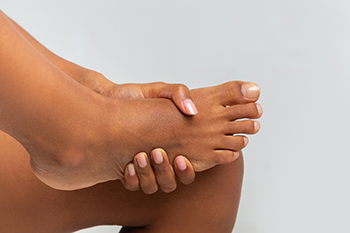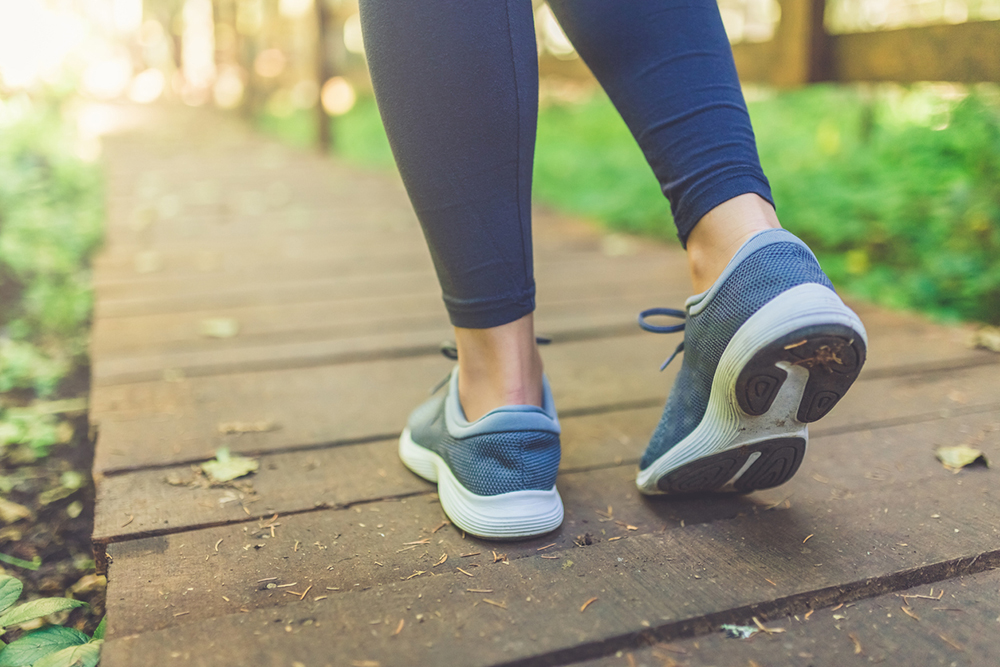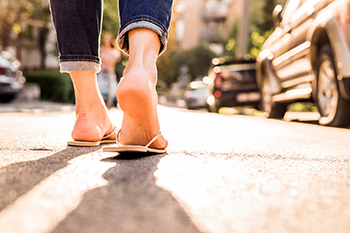Items filtered by date: November 2023
Definition and Progression of a Plantar Fibroma

A plantar fibroma affects the foot's plantar fascia, resulting in the development of nodules or fibrous tissue. Characterized by a thickening of the ligament that supports the arch, this disorder commonly manifests on the bottom of the foot, near the heel. In its early stages, a plantar fibroma may present as a small, painless nodule. As the condition progresses, these nodules can enlarge and become tender, causing discomfort with weight-bearing activities like walking or standing. Over time, the fibrous tissue may intertwine with the plantar fascia, potentially leading to a reduction in foot flexibility. The stages of a plantar fibroma vary, with some cases remaining relatively stable, while others may experience increased symptoms. Understanding the definition and progression of a plantar fibroma is essential for early recognition and intervention, enabling individuals to explore appropriate management strategies and maintain optimal foot health. If you have discomfort on the bottom of your foot, it is suggested that you visit a podiatrist who can accurately diagnose and treat a plantar fibroma.
A plantar fibroma may disrupt your daily activities. If you have any concerns, contact Kentston Cripe, DPM of Roseville Foot & Ankle. Our doctor can provide the care you need to keep you pain-free and on your feet.
Plantar Fibroma
A plantar fibroma is a fibrous knot in the arch of the foot. It is embedded in the plantar fascia which is a band of tissue that extends from the heel to the toes along the bottom of the foot. There can be multiple plantar fibromas in the feet at the same time. There are no known causes for this condition. If you have a plantar fibroma, there will be a bump in the arch of your foot that cannot be missed. Any associated pain is most often due to a shoe rubbing against the nodule. Non-surgical options, such as steroid injections, physical therapy, and orthotics should be tried first. Surgery is a last resort and is the only thing that will remove a plantar fibroma entirely. Consult with a podiatrist for a proper diagnosis and to determine the treatment regimen that is right for you.
What Causes a Plantar Fibroma?
While there are no specific causes identified, a plantar fibroma can possibly come from genetic predisposition or the formation of scar tissue that forms from healing the tears in the plantar fascia.
What Are the Symptoms of a Plantar Fibroma?
There will be a noticeable lump in the arch of the foot that may or may not cause pain. If pain is felt, it is typically because a shoe is rubbing up against the lump or when walking or standing barefoot.
Treatment and Prevention
A plantar fibroma will not disappear without treatment, but it can get smaller and be a non-issue. If pain persists, a podiatrist examines the foot and when the arch of the foot is pressed, pain can be felt down to the toes. An MRI or biopsy might be performed to help diagnose or evaluate the plantar fibroma. The following non-surgical options are generally enough to reduce the size and pain of these nodules:
- Steroid injections
- Orthotics
- Physical therapy to help apply anti-inflammatory creams on the bump
Surgery is considered if the mass increases in size and the patient continues to feel pain after non-surgical methods are tried.
If you have any questions please feel free to contact our office located in Roseville, CA . We offer the newest diagnostic tools and technology to treat your foot and ankle needs.
We Can Treat Your Foot or Ankle Pain
Is It a Good Idea to Run In Walking Shoes?

Many people wonder whether it is acceptable to run in walking shoes. While walking shoes are designed for a different purpose than running shoes, the answer is not always a straightforward yes or no. Walking shoes are generally built with a focus on providing comfort, stability, and support during low-impact activities like walking. They often have less cushioning and flexibility compared to running shoes, which are designed to absorb the higher impact forces generated during running. For short, light jogging or occasional runs, walking shoes may suffice, especially if you do not experience discomfort or pain. However, if you plan to run regularly or for longer distances, investing in running-specific footwear is recommended. Running shoes offer the necessary cushioning, shock absorption, and flexibility designed to protect your feet and joints from the impact of running. Ultimately, choosing the right footwear depends on your activity level and goals. If you are serious about running, it is best to invest in a proper pair of running shoes to reduce the risk of injury and enhance your performance. If you would like additional information about walking and running shoes, it is suggested that you confer with a podiatrist who can provide you with the knowledge you are seeking.
For more information about walking shoes versus running shoes, consult with Kentston Cripe, DPM from Roseville Foot & Ankle. Our doctor can measure your feet to determine what your needs are and help you find an appropriate pair of footwear.
Foot Health: The Differences between Walking & Running Shoes
There are great ways to stay in shape: running and walking are two great exercises to a healthy lifestyle. It is important to know that running shoes and walking shoes are not interchangeable. There is a key difference on how the feet hit the ground when someone is running or walking. This is why one should be aware that a shoe is designed differently for each activity.
You may be asking yourself what the real differences are between walking and running shoes and the answers may shock you.
Differences
Walking doesn’t involve as much stress or impact on the feet as running does. However, this doesn’t mean that you should be any less prepared. When you’re walking, you land on your heels and have your foot roll forward. This rolling motion requires additional support to the feet.
Flexibility – Walking shoes are designed to have soft, flexible soles. This allows the walker to push off easily with each step.
If you have any questions, please feel free to contact our office located in Roseville, CA . We offer the newest diagnostic and treatment technologies for all your foot care needs.
Causes of Big Toe Joint Pain

One of the most important components of your foot is the big toe joint, scientifically known as the first metatarsophalangeal joint, or first MPJ. When issues arise within this joint, they can significantly impact your daily life, ranging from walking to overall body posture. Hallux limitus is a condition that pertains to the limited range of motion in the big toe joint. One of the main causes of this condition is inflammatory arthritis. Your big toe joint plays a critical role in walking and maintaining proper balance. When this joint loses its range of motion it can lead to significant difficulties in walking and cause pain during each step. This can alter the gait and in turn affect the knee, hip, and back. If arthritis is a contributing factor, disease specific medications can be prescribed. In severe cases, surgical intervention may be needed. Procedures can range from cleaning out the joint to more advanced surgeries, such as joint fusion or joint replacement. For an accurate appraisal of the problems involving your big toe pain, it is suggested that you make an appointment with a podiatrist.
Toe pain can disrupt your daily activities. If you have any concerns, contact Kentston Cripe, DPM of Roseville Foot & Ankle. Our doctor can provide the care you need to keep you pain-free and on your feet.
What Causes Toe Pain?
Most severe toe pain is caused due to a sports injury, trauma from dropping something heavy on the toe, or bumping into something rigid. Other problems can develop over time for various reasons.
Toe pain can be caused by one or more ailments. The most common include:
- Trauma
- Sports injury
- Wearing shoes that are too tight
- Arthritis
- Gout
- Corns and calluses
- Hammertoe
- Bunions
- Blisters
- Ingrown toenails
- Sprains
- Fractures (broken bones)
- Dislocations
When to See a Podiatrist
- Severe pain
- Persistent pain that lasts more than a week
- Signs of infection
- Continued swelling
- Pain that prevents walking
Diagnosis
In many cases the cause of toe pain is obvious, but in others, a podiatrist may want to use more advanced methods to determine the problem. These can range from simple visual inspections and sensation tests to X-rays and MRI scans. Prior medical history, family medical history, and any recent physical traumatic events will all be taken into consideration for a proper diagnosis.
Treatment
Treatments for toe pain and injuries vary and may include shoe inserts, padding, taping, medicines, injections, and in some cases, surgery. If you believe that you have broken a toe, please see a podiatrist as soon as possible.
If you have any questions please feel free to contact our office located in Roseville, CA . We offer the newest diagnostic tools and technology to treat your foot and ankle needs.
Fungal and Bacterial Infections From Wearing Flip-Flops

Wearing flip-flops leaves your feet vulnerable to various infections, from bacteria to viruses. When your feet are exposed in public places, harmful organisms, such as staphylococcus, can cling to them. This bacterium can cause skin irritation, and in extreme cases, serious foot conditions may emerge. The risk increases if you have open sores or even small wounds from recent pedicures. Another concern is athlete's foot, which is a contagious fungal infection that causes itching. Walking with minimal footwear increases the chances of encountering and contracting this fungus. You also risk exposure to the virus responsible for warts, which is HPV, while wearing flip-flops. If you enjoy wearing flip-flops, it is suggested that you make an appointment with a podiatrist to discuss similarly easy and comfortable footwear alternatives that are healthier for your feet.
Flip-flops are not always the best choice of footwear. If you have any concerns about your feet or ankles, contact Kentston Cripe, DPM from Roseville Foot & Ankle. Our doctor will assist you with all of your foot and ankle needs.
Flip-Flops and Feet
When the weather starts warming up, people enjoy wearing flip-flops. Flip-flops are comfortable, stylish, and easy to slip on and off; they're perfect for any summer beach goer. However, these shoes can cause harm to the feet.
How Can Flip-Flops Affect Me Long-Term?
- Ankle problems
- Hip problems
- Lower back problems
- Pain in the balls of the feet
- Problems with foot arches
- Changes in the way you walk
Are There Injuries Associated with Flip-Flops?
Yes. Since flip-flops are relatively weak and do not provide the same amount of support as sneakers, people who wear flip-flops regularly are more susceptible to injuries. On top of that, the open nature of the shoe makes your feet more prone to other problems, such as cuts and even infections. Common injuries and ailments include:
- Sprained ankles
- Blisters
- Infections
- Cuts and Scrapes
I like Wearing Flip-Flops. Are There Safe Alternatives?
When buying flip-flops, try to find ones that have sturdy soles and that are made of high-quality materials that will support for your feet. These flip-flops will cost more but will also last longer as a result.
If you have any questions please feel free to contact our office located in Roseville, CA . We offer the newest diagnostic and treatment technologies for all your foot and ankle needs.

